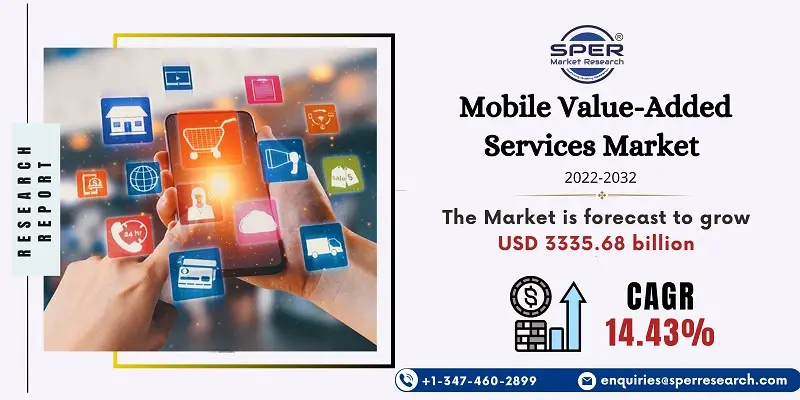
Mobile Value-Added Services Market Growth, Size, Trends, Share, Demand and Future Outlook
Mobile Value-Added Services Market Size- By Vertical, By Solution, By End User - Regional Outlook, Competitive Strategies and Segment Forecast to 2032
| Published: Dec-2022 | Report ID: IACT2232 | Pages: 1 - 243 | Formats*: |
| Category : Information & Communications Technology | |||
- In August 2023, Singtel, a well-known Singaporean telecoms provider, announced the launch of new 5G plans for its customers. These new plans also offered some unique value-added features at a low cost.
- In January 2021, Weiyouxin Technology, a private domain SaaS software operating service provider, obtained funding from ZW Data Action Technologies, Inc. (the US), which provides integrated data analytics, online advertising, precision marketing, and other value-added services.
- In January 2021, BSNL (India) granted PertSol (Part Telecom Solutions Pvt Ltd.) a Rs 30 crore contract to deploy a Location Based System (LBS) for their 2G, 3G, and 4G networks across India. According to the Unified Access Service License (UASL) regulations, the telecom department mandated the installation of LBS in 2014.

- Regulatory Compliance: Mobile value-added service providers will encounter several regulatory compliance challenges and will be required to comply with all of them, which may entail surrendering some functionality or cutting earnings to some level, delaying the expansion of the mobile value-added services market.
- The fragmentation of mobile ecosystems: Mobile ecosystems have gotten more diverse, and in order to ensure that all mobile value added services function properly, market players would need to invest more in research and development, which may reduce profit margins. This is why a diverse mobile ecosystem may impede the growth of the mobile value-added services market in the coming years.

| Report Metric | Details |
| Market size available for years | 2019-2032 |
| Base year considered | 2021 |
| Forecast period | 2022-2032 |
| Segments covered | By Solution, By Vertical, By End User |
| Regions covered | North America, Asia-Pacific, Latin America, Middle East & Africa and Europe |
| Companies Covered | Reliance Industries Ltd, Comviva Technologies, Alphabet Inc, Samsung Electronics Co Ltd, One97 Communications, Huawei Investment & Holding Co Ltd, OnMobile Global Limited, Mozat Pte Ltd, Vodafone Group plc, Apple Inc. |
- Mobile Network Operators (MNOs)
- Content Providers
- Application Developers
- Mobile Device Manufacturers
- Consumers
- Enterprise Customers
- Advertisers and Marketers
- Government and Public Sector
- Healthcare Providers
- Educational Institutions
| By Solution: |
|
| By End-User: |
|
| By Vertical: |
|
- Global Mobile Value Added Services (MVAS) Market Size (FY’2022-FY’2032)
- Overview of Global Mobile Value Added Services (MVAS) Market By Solution (Location Based Services, Mobile Advertising, Mobile Email & IM, Mobile Infotainment, Mobile Money, Multimedia Messaging Service (MMS), Short Messaging Service (SMS) and Others)
- Segmentation of Global Mobile Value Added Services (MVAS) Market By Vertical (Media and Entertainment, Education, Government, Healthcare, Retail, Telecom and IT and Others)
- Segmentation of Global Mobile Value Added Services (MVAS) Market By End User (Large Enterprises and SMB.)
- Statistical Snap of Global Mobile Value Added Services (MVAS) Market
- Expansion Analysis of Global Mobile Value Added Services (MVAS) Market
- Problems and Obstacles in Global Mobile Value Added Services (MVAS) Market
- Competitive Landscape in the Global Mobile Value Added Services (MVAS) Market
- Impact of COVID-19 and Demonetization on Global Mobile Value Added Services (MVAS) Market
- Details on Current Investment in Global Mobile Value Added Services (MVAS) Market
- Competitive Analysis of Global Mobile Value Added Services (MVAS) Market
- Prominent Players in the Global Mobile Value Added Services (MVAS) Market
- SWOT Analysis of Global Mobile Value Added Services (MVAS) Market
- Global Mobile Value Added Services (MVAS) Market Future Outlook and Projections (FY’2022-FY’2032)
- Recommendations from Analyst
1.1. Scope of the report1.2. Market segment analysis
2.1. Research data source
2.1.1. Secondary Data2.1.2. Primary Data2.1.3. SPER’s internal database2.1.4. Premium insight from KOL’s
2.2. Market size estimation
2.2.1. Top-down and Bottom-up approach
2.3. Data triangulation
4.1. Driver, Restraint, Opportunity and Challenges analysis4.1.1. Drivers4.1.2. Restraints4.1.3. Opportunities4.1.4. Challenges4.2. COVID-19 Impacts of the Global Mobile Value-Added Services Market.
5.1. SWOT Analysis5.1.1. Strengths5.1.2. Weaknesses5.1.3. Opportunities5.1.4. Threats5.2. PESTEL Analysis5.2.1. Political Landscape5.2.2. Economic Landscape5.2.3. Social Landscape5.2.4. Technological Landscape5.2.5. Environmental Landscape5.2.6. Legal Landscape5.3. PORTER’s Five Forces5.3.1. Bargaining power of suppliers5.3.2. Bargaining power of buyers5.3.3. Threat of Substitute5.3.4. Threat of new entrant5.3.5. Competitive rivalry5.4. Heat Map Analysis
6.1. Global Mobile Value-Added Services Market Manufacturing Base Distribution, Sales Area, Product Type6.2. Mergers & Acquisitions, Partnerships, Product Launch, and Collaboration in Global Mobile Value-Added Services Market
7.1. Global Mobile Value-Added Services Market Size, Share and Forecast, By Solution, 2019-20257.2. Global Mobile Value-Added Services Market Size, Share and Forecast, By Solution, 2026-20327.3. Short Messaging Service7.4. Multimedia Messaging Service7.5. Location Based Services7.6. Mobile Email & IM7.7. Mobile Money7.8. Mobile Advertising7.9. Mobile Infotainment7.10. Others
8.1. Global Mobile Value-Added Services Market Size, Share and Forecast, By End-User, 2019-20258.2. Global Mobile Value-Added Services Market Size, Share and Forecast, By End-User, 2026-20328.3. SMB8.4. Large Enterprises
9.1. Global Mobile Value-Added Services Market Size, Share and Forecast, By Vertical, 2019-20259.2. Global Mobile Value-Added Services Market Size, Share and Forecast, By Vertical, 2026-20329.3. Media and Entertainment9.4. Healthcare9.5. Education9.6. Retail9.7. Government9.8. Telecom and IT9.9. Others
10.1. Global Mobile Value-Added Services Market Size and Market Share
11.1. Global Mobile Value-Added Services Market Size and Market Share By Region (2019-2025)11.2. Global Mobile Value-Added Services Market Size and Market Share By Region (2026-2032)11.3. Asia-Pacific11.3.1. Australia11.3.2. China11.3.3. India11.3.4. Japan11.3.5. South Korea11.3.6. Rest of Asia-Pacific11.4. Europe11.4.1. France11.4.2. Germany11.4.3. Italy11.4.4. Spain11.4.5. United Kingdom11.4.6. Rest of Europe11.5. Middle East and Africa11.5.1. Kingdom of Saudi Arabia11.5.2. United Arab Emirates11.5.3. Qatar11.5.4. South Africa11.5.5. Egypt11.5.6. Morocco11.5.7. Nigeria11.5.8. Rest of Middle-East and Africa11.6. North America11.6.1. Canada11.6.2. Mexico11.6.3. United States11.7. Latin America11.7.1. Argentina11.7.2. Brazil11.7.3. Rest of Latin America
12.1. Apple Inc12.1.1. Company details12.1.2. Financial outlook12.1.3. Product summary12.1.4. Recent developments12.2. Comviva Technologies12.2.1. Company details12.2.2. Financial outlook12.2.3. Product summary12.2.4. Recent developments12.3. Alphabet Inc12.3.1. Company details12.3.2. Financial outlook12.3.3. Product summary12.3.4. Recent developments12.4. Samsung Electronics Co. Ltd12.4.1. Company details12.4.2. Financial outlook12.4.3. Product summary12.4.4. Recent developments12.5. One97 Communications12.5.1. Company details12.5.2. Financial outlook12.5.3. Product summary12.5.4. Recent developments12.6. Huawei Investment & Holding Co. Ltd12.6.1. Company details12.6.2. Financial outlook12.6.3. Product summary12.6.4. Recent developments12.7. OnMobile Global Limited12.7.1. Company details12.7.2. Financial outlook12.7.3. Product summary12.7.4. Recent developments12.8. Mozat Pte Ltd12.8.1. Company details12.8.2. Financial outlook12.8.3. Product summary12.8.4. Recent developments12.9. Reliance Industries Ltd12.9.1. Company details12.9.2. Financial outlook12.9.3. Product summary12.9.4. Recent developments12.10. Vodafone Group plc12.10.1. Company details12.10.2. Financial outlook12.10.3. Product summary12.10.4. Recent developments12.11. Others
SPER Market Research’s methodology uses great emphasis on primary research to ensure that the market intelligence insights are up to date, reliable and accurate. Primary interviews are done with players involved in each phase of a supply chain to analyze the market forecasting. The secondary research method is used to help you fully understand how the future markets and the spending patterns look likes.
The report is based on in-depth qualitative and quantitative analysis of the Product Market. The quantitative analysis involves the application of various projection and sampling techniques. The qualitative analysis involves primary interviews, surveys, and vendor briefings. The data gathered as a result of these processes are validated through experts opinion. Our research methodology entails an ideal mixture of primary and secondary initiatives.



Frequently Asked Questions About This Report
PLACE AN ORDER
Year End Discount
Sample Report
Pre-Purchase Inquiry
NEED CUSTOMIZATION?
Request CustomizationCALL OR EMAIL US
100% Secure Payment






Related Reports
Our Global Clients
Our data-driven insights have influenced the strategy of 200+ reputed companies across the globe.






















